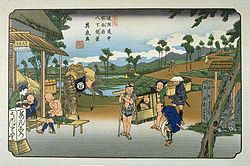-
The Date clan's norimono with arabesque design in maki-e lacquer. Edo period, Tokyo Fuji Art Museum.
Kago
 From Wikipedia - Reading time: 5 min
From Wikipedia - Reading time: 5 min

A kago (駕籠) is a type of litter used as a means of human transportation by the non-samurai class in feudal Japan and into the Meiji period (1868–1911).
Description and use
[edit]
The basket of a kago was roughly 3 ft (0.91 m) long, and attached to bamboo uprights which were suspended by a large overhead single crossbeam. A roof of some type covered the top and screens could be used to cover the sides as protection from sun or rain. A kago would be carried by a team of four men, who would take turns carrying the kago on their shoulders; five or six miles could be traveled in one hour. One man would support the weight of the large overhead pole at each end and walked until he tired and switched with a rested carrier.[1][2] The kago should not be confused with the more elaborate norimono, which were used by the samurai class and wealthy individuals.[3][4]
References
[edit]- ^ An artist's letters from Japan, Author John La Farge, Publisher The Century co., 1897, Original from the University of California, Digitized Mar 13, 2009 P.277
- ^ Belgravia, Volume 35, Author Mary Elizabeth Braddon, Publisher Willmer & Rogers, 1878 p.58
- ^ The Nautical magazine: a journal of papers on subjects connected with maritime affairs, Volume 11, Publisher Brown, Son and Ferguson, 1842. Original from, Oxford University, P.330
- ^ Kaempfer's Japan: Tokugawa culture observed, Authors Engelbert Kaempfer, Beatrice M. Bodart-Bailey, Editor Beatrice M. Bodart-Bailey, Translated by Beatrice M. Bodart-Bailey, Edition illustrated, Publisher University of Hawaii Press, 1999, ISBN 978-0-8248-2066-4 P.246
External links
[edit] Media related to Kago (Japanese litter) at Wikimedia Commons
Media related to Kago (Japanese litter) at Wikimedia Commons
18 views | Status: cached on April 14 2025 13:12:46
↧ Download as ZWI file
 KSF
KSF